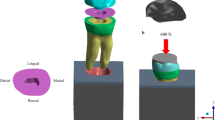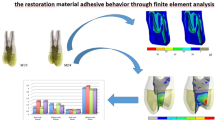Abstract
Objectives
Until now, it is not clear if various procedures of bracket debonding differ with regard to their risk of enamel fracture. Therefore, the objective of the present study was to compare these procedures biomechanically for assessing the risk of complications.
Materials and methods
An anisotropic finite element method (FEM) model of the mandibular bone including periodontal ligament, enamel, dentin, and an orthodontic bracket was created. The morphology based on the CT data of an anatomical specimen. Typical loading conditions were defined for each method of bracket debonding (compression, shearing off, twisting off). Shortly before the adhesive’s break, the induced stress in enamel, periodontal ligament, and in the alveolar bone was measured. The statistical analysis of the obtained values was performed in SPSS 19.0.
Results
Relatively high stresses occurred in the enamel using frontal torque (max. 44.18 MPa). With shearing off, the stresses were also high (max. 41.96 MPa), and additionally high loads occurred on the alveolar bone as well (max. 11.79 MPa). Moderate maximum values in enamel and alveolar bone appeared during the compression of the bracket wings (max. 37.12 MPa) and during debonding by lateral torque (max. 35.18 MPa).
Conclusions
The present simulation results indicate that the risk of enamel fracture may depend on the individual debonding procedure. Further clinical trials are necessary to confirm that.
Clinical relevance
For patients with prior periodontal disease or loosened teeth, a debonding procedure by compression of the bracket wings is recommended, since here the load for the periodontal structures of the tooth is lowest.








Similar content being viewed by others
References
Bishara SE, Khowassah MA, Oesterle LJ (1975) Effect of humidity and temperature changes on orthodontic direct-bonding adhesive systems. J Dent Res 54:751–758
Buonocore MG, Matsui A, Gwinnett AJ (1968) Penetration of resin dental materials into enamel surfaces with reference to bonding. Arch Oral Biol 13:61–70
Faust JB, Grego GN, Fan PL, Powers JM (1978) Penetration coefficient, tensile strength, and bond strength of thirteen direct bonding orthodontic cements. Am J Orthod 73:512–525
Knoll M, Gwinnett AJ, Wolff MS (1986) Shear strength of brackets bonded to anterior and posterior teeth. Am J Orthod 89:476–479
Lin L, Huang SF, Tsai HC, Chang WJ (2011) Finite element submodeling analyses of damage to enamel at the incisor enamel/adhesive interface upon de-bonding for different orthodontic bracket bases. J Biomech 44:134–142
Meng CL, Li CH, Wang WN (1998) Bond strength with APF applied after acid etching. Am J Orthod Dentofacial Orthop 114:510–513
Sorel O, Alam R, Chagneau F, Cathelineau G (2000) Changes in the enamel after in vitro debonding of brackets bonded with a modified glass ionomer cement. Orthod Francaise 71:155–163
Chen CS, Hsu ML, Chang KD, Kuang SH, Chen PT, Gung YW (2008) Failure analysis: enamel fracture after debonding orthodontic brackets. Angle Orthod 78:1071–1077
Ryf S, Flury S, Palaniappan S, Lussi A, van Meerbeek B, Zimmerli B (2012) Enamel loss and adhesive remnants following bracket removal and various clean-up procedures in vitro. Eur J Orthod 34:25–32
Shinya M, Shinya A, Lassila LV, Gomi H, Varrela J, Vallittu PK, Shinya A (2008) Treated enamel surface patterns associated with five orthodontic adhesive systems—surface morphology and shear bond strength. Dent Mat J 27:1–6
Bishara SE, Fehr DE (1997) Ceramic brackets: something old, something new, a review. Semin Orthod 3:178–188
Stratmann U, Schaarschmidt K, Wegener H, Ehmer U (1996) The extent of enamel surface fractures. A quantitative comparison of thermally debonded ceramic and mechanically debonded metal brackets by energy dispersive micro- and image-analysis. Eur J Orthod 18:655–62
Naini FB, Gill DS (2008) Tooth fracture associated with debonding a metal orthodontic bracket: a case report. World J Orthod 9:e32–36
Scougall Vilchis RJ, Yamamoto S, Kitai N, Yamamoto K (2009) Shear bond strength of orthodontic brackets bonded with different self-etching adhesives. Am J Orthod Dentofacial Orthop 136:425–430
Ogaard B, Bishara SE, Duschner H (2004) Enamel effects during bonding-debonding and treatment with fixed appliances. In: Graber TM, Eliades T, Athanasiou AE (eds) Risk management in orthodontics: experts guide to malpractice. Quintessence, Chicago, pp 19–46
Odegaard J, Segner D (1988) Shear bond strength of metal brackets compared with a new ceramic bracket. Am J Orthod Dentofacial Orthop 94:201–206
Redd TB, Shivapura PK (1991) Debonding ceramic brackets: effects on enamel. J Clin Orthod 99:97–99
Habibi M, Nik TH, Hooshmand T (2007) Comparison of the debonding characteristics of metal and ceramic orthodontic brackets to enamel: an in-vitro study. Am J Orthod Dentofacial Orthop 132:675–679
Fischer-Brandies H, Kremers L, Reicheneder C, Kluge G, Hüsler K (1993) Enamel damage depending on the method of bracket removal. J Orofac Orthop 54:64–70
Cattaneo PM, Dalstra M, Melsen B (2005) The finite element method: a tool to study orthodontic tooth movement. J Dent Res 84:428–433
Chang YI, Baek SH (2004) Three-dimensional finite element analysis in distal en masse movement of the maxillary dentition with the multiloop edgewise archwire. Eur J Orthod 26:339–345
Kojima Y, Fukui H (2005) Numerical simulation of canine retraction by sliding mechanics. Am J Orthod Dentofacial Orthop 127:542–551
Motoyoshi M, Yano S, Tsuruoka T, Shimizu N (2005) Biomechanical effect of abutment on stability of orthodontic mini-implant. A finite element analysis. Clin Oral Implants Res 16:480–485
Suzuki A, Masuda T, Takahashi I, Deguchi T, Suzuki O, Takano-Yamamoto T (2011) Changes in stress distribution of orthodontic miniscrews and surrounding bone evaluated by 3-dimensional finite element analysis. Am J Orthod Dentofacial Orthop 140:e273–280
Woodall N, Tadepalli SC, Qian F, Grosland NM, Marshall SD, Southard TE (2011) Effect of miniscrew angulation on anchorage resistance. Am J Orthod Dentofacial Orthop 139:e147–152
Liu TC, Chang CH, Wong TY, Liu JK (2012) Finite element analysis of miniscrew implants used for orthodontic anchorage. Am J Orthod Dentofacial Orthop 141:468–476
Singh S, Mogra S, Shetty VS, Shetty S, Philip P (2012) Three-dimensional finite element analysis of strength, stability and stress distribution in orthodontic anchorage: a conical, self-drilling miniscrew implant system. Am J Orthod Dentofacial Orthop 141:327–336
Dechow PC, Nail GA, Schwartz-Dabney CL, Ashman RB (1993) Elastic properties of human supraorbital and mandibular bone. Am J Phys Anthropol 90:291–306
O’Mahony M, Williams JL, Katz JO, Spencer P (2000) Anisotropic elastic properties of cancellous bone from a human edentulous mandible. Clin Oral Implants Res 11:415–421
O’Mahony M, Williams JL, Spencer P (2001) Anisotropic elasticity of cortical and cancellous bone in the posterior mandible increases peri-implant stress and strain under oblique loading. Clin Oral Implants Res 12:648–657
Xu HH, Smith DT, Jahanmir S, Romberg E, Kelly JR, Thompson VP, Rekow ED (1998) Indentation damage and mechanical properties of human enamel and dentin. J Dent Res 77:472–480
Kinney JH, Gladden JR, Marshall GW, Marshall SJ, So JH, Maynard JD (2004) Resonant ultrasound spectroscopy measurements of the elastic constants of human dentin. J Biomech 37:437–441
Rees JS, Jacobsen PH (1997) Elastic modulus of the periodontal ligament. Biomaterials 18:995–999
Borschel GH, Kia KF, Kuzon WM, Dennis RG (2003) Mechanical properties of acellular peripheral nerve. J Surg Res 114:133–139
Ichihara K, Taguchi T, Shimada Y, Sakuramoto I, Kawano S, Kawai S (2001) Gray matter of the bovine cervical spinal cord is mechanically more rigid and fragile than the white matter. J Neurotrauma 18:361–367
Chen F, Terada K, Handa K (2005) Anchorage effect of various shape palatal osseointegrated implants: a finite element study. Angle Orthod 75:378–385
Pickard MB, Dechow P, Rossouw PE, Buschang PH (2010) Effects of miniscrew orientation on implant stability and resistance to failure. Am J Orthod Dentofacial Orthop 137:91–99
Lombardo L, Gracco A, Zampini F, Stefanoni F, Mollica F (2010) Optimal palatal configuration for miniscrew applications. Angle Orthod 80:145–152
Brosh T, Kaufman A, Balabanovsky A, Vardimon AD (2005) In vivo debonding strength and enamel damage in two orthodontic debonding methods. J Biomech 38:1107–1113
Normando TS, Calçada FS, Ursi WJ, Normando D (2010) Patients' report of discomfort and pain during debonding of orthodontic brackets: a comparative study of two methods. World J Orthod 11:e29–34
Conflict of interest
The authors declare that they have no conflict of interest.
Author information
Authors and Affiliations
Corresponding author
Rights and permissions
About this article
Cite this article
Holberg, C., Winterhalder, P., Holberg, N. et al. Orthodontic bracket debonding: risk of enamel fracture. Clin Oral Invest 18, 327–334 (2014). https://doi.org/10.1007/s00784-013-0969-4
Received:
Accepted:
Published:
Issue Date:
DOI: https://doi.org/10.1007/s00784-013-0969-4




